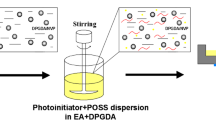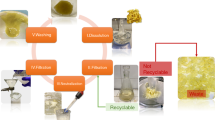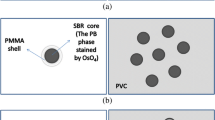Abstract
Digital light processing vat photopolymerization (DLP 3D printing) technique are being widely applied in prototype design and engineering parts preparation. DLP 3D printing technique adopts acrylate resin as raw material which generate cross-linking network through free radical polymerization, hence fabricated parts are usually brittle and fragile. Although molecular modification for acrylate is an effective way to improve the flexibility of the printed part, the high modulus of the parts decreased greatly. In recent years, core–shell nanoparticles (CSP) have proved to be an effective toughening agent for epoxy, nevertheless the dispersibility and stability in acrylate and corresponding toughening effects are still unclear. In this work, by taking advantage of the excellent dispersibility of CSP in epoxy, acrylate modified CSP emulsions were prepared by in situ modification approach. In brief, the CSP with a silicone core and epoxy grafted shell was first prepared and dispersed in the epoxy matrix. Remained epoxy functional groups were modified to acrylate functional groups through a ring-opening reaction with acrylate acid. Compounded with oligomers and reactive diluents, a toughened 3D printable UV-curable resin was prepared. The characterization results showed that the flexural strength was improved by 30% at an addition of 3% w/w of CSP, and the impact strength was improved by 147.9% at an addition of 7% w/w of CSP. This in situ modified toughened UV-curable resin also provides a higher stability for a longer shelf life. Dimensional accuracy tests also proved as-prepared UV-curable resin can print a refined structure. This low viscosity, high printing accuracy and good stability of toughened CSP/UV-curable resin nanocomposite has potential contribution to the applications for vat photopolymerization in engineering field.








Similar content being viewed by others
Data availability
The datasets generated during and/or analyzed during the current study are available from the corresponding author on reasonable request.
References
Karakurt I, Lin L (2020) 3D printing technologies: techniques, materials, and post-processing. Curr Opin Chem Eng 28:134–143. https://doi.org/10.1016/j.coche.2020.04.001
Ligon SC, Liska R, Stampfl J, Gurr M, Mülhaupt R (2017) Polymers for 3D Printing and Customized Additive Manufacturing. Chem Rev 117:10212–10290. https://doi.org/10.1021/acs.chemrev.7b00074
Peng S, Wang Z, Lin J, Miao J, Zheng L, Yang Z, Weng Z, Wu L (2021) Tailored and Highly Stretchable Sensor Prepared by Crosslinking an Enhanced 3D Printed UV-Curable Sacrificial Mold. Adv Funct Mater 31:2008729. https://doi.org/10.1002/adfm.202008729
Peng X, Kuang X, Roach DJ, Wang Y, Hamel CM, Lu C, Qi HJ (2021) Integrating digital light processing with direct ink writing for hybrid 3D printing of functional structures and devices. Addit Manuf 40:101911. https://doi.org/10.1016/j.addma.2021.101911
Roberts C, Bourell D (2018) Precursor Additive Manufacturing Inventions. JOM 70:2249–2253. https://doi.org/10.1007/s11837-018-2809-0
Zhu G, Hou Y, Xu J, Zhao N (2021) Reprintable Polymers for Digital Light Processing 3D Printing. Adv Funct Mater 31:2007173. https://doi.org/10.1002/adfm.202007173
Chen Z, Li Z, Li J, Liu C, Lao C, Fu Y, Liu C, Li Y, Wang P, He Y (2019) 3D printing of ceramics: A review. J Eur Ceram Soc 39:661–687. https://doi.org/10.1016/j.jeurceramsoc.2018.11.013
Aboulkhair NT, Simonelli M, Parry L, Ashcroft I, Tuck C, Hague R (2019) 3D printing of Aluminium alloys: Additive Manufacturing of Aluminium alloys using selective laser melting. Prog Mater Sci 106:100578. https://doi.org/10.1016/j.pmatsci.2019.100578
Peng S, Guo Q, Thirunavukkarasu N, Zheng Y, Wang Z, Zheng L, Wu L, Weng Z (2022) Tailoring of photocurable ionogel toward high resilience and low hysteresis 3D printed versatile porous flexible sensor. Chem Eng J 439:135593. https://doi.org/10.1016/j.cej.2022.135593
Yan C, Zhang X, Ji Z, Wang X, Zhou F (2021) 3D-Printed Electromagnetic Actuator for Bionic Swimming Robot. J Mater Eng Perform 30:6579–6587. https://doi.org/10.1007/s11665-021-05918-7
Jiao C, Sun L, Shao Q, Song J, Hu Q, Naik N, Guo Z (2021) Advances in Waterborne Acrylic Resins: Synthesis Principle, Modification Strategies, and Their Applications. ACS Omega 6:2443–2449. https://doi.org/10.1021/acsomega.0c05593
Xu J, Jiang Y, Zhang T, Dai Y, Yang D, Qiu F, Yu Z, Yang P (2018) Synthesis of UV-curing waterborne polyurethane-acrylate coating and its photopolymerization kinetics using FT-IR and photo-DSC methods. Prog Org Coat 122:10–18. https://doi.org/10.1016/j.porgcoat.2018.05.008
Peng S, Li Y, Wu L, Zhong J, Weng Z, Zheng L, Yang Z, Miao J-T (2020) 3D Printing Mechanically Robust and Transparent Polyurethane Elastomers for Stretchable Electronic Sensors. ACS Appl Mater Interfaces 12:6479–6488. https://doi.org/10.1021/acsami.9b20631
Maurya SD, Kurmvanshi SK, Mohanty S, Nayak SK (2018) A Review on Acrylate-Terminated Urethane Oligomers and Polymers: Synthesis and Applications. Polym-Plast Technol Eng 57:625–656. https://doi.org/10.1080/03602559.2017.1332764
Bao F, Shi W (2010) Synthesis and properties of hyperbranched polyurethane acrylate used for UV curing coatings. Prog Org Coat 68:334–339. https://doi.org/10.1016/j.porgcoat.2010.03.002
Yu R, Yang X, Zhang Y, Zhao X, Wu X, Zhao T, Zhao Y, Huang W (2017) Three-Dimensional Printing of Shape Memory Composites with Epoxy-Acrylate Hybrid Photopolymer. ACS Appl Mater Interfaces 9:1820–1829. https://doi.org/10.1021/acsami.6b13531
Zhang X, Xu Y, Li L, Yan B, Bao J, Zhang A (2019) Acrylate-based photosensitive resin for stereolithographic three-dimensional printing. J Appl Polym Sci 136:47487. https://doi.org/10.1002/app.47487
Li S, Sun D, Li A, Cui Y (2021) Study on curing shrinkage and mechanism of DHOM-modified epoxy-acrylate-based UV-curing 3D printing materials. J Appl Polym Sci 138:49859. https://doi.org/10.1002/app.49859
Desai P, Jagtap R (2022) Synthesis of ultraviolet curable bisphenol-based epoxy acrylates and comparative study on its physico-chemica properties. J of Applied Polymer Sci 139:52022. https://doi.org/10.1002/app.52022
Gurr M, Thomann Y, Nedelcu M, Kübler R, Könczöl L, Mülhaupt R (2010) Novel acrylic nanocomposites containing in-situ formed calcium phosphate/layered silicate hybrid nanoparticles for photochemical rapid prototyping, rapid tooling and rapid manufacturing processes. Polymer 51:5058–5070. https://doi.org/10.1016/j.polymer.2010.08.026
Li H, Zhao L, Su K, Feng H, Wang D, Qu C (2021) A comparative study on the rheological, thermal, and mechanical performance of epoxy resin modified with thermoplastics. J Adhes Sci Technol 35:1393–1403. https://doi.org/10.1080/01694243.2020.1849982
Dorigato A, Rigotti D, Pegoretti A (2020) Novel Poly(Caprolactone)/Epoxy blends by additive manufacturing. Mater 13:819. https://doi.org/10.3390/ma13040819
Yang Z, Peng S, Wang Z, Miao J-T, Zheng L, Wu L, Weng Z (2022) UV-Curable, Low-Viscosity Resin with a High Silica Filler Content for Preparing Ultrastiff, 3D-Printed Molds. ACS Appl Polym Mater 4:2636–2647. https://doi.org/10.1021/acsapm.1c01920
Ai J, Cheng W, Wang P, Qian W, Chen Q (2021) Silica solid particles toughening, strengthening and anti-aging on epoxy resin. J Appl Polym Sci 138:50331. https://doi.org/10.1002/app.50331
Ravindran AR, Ladani RB, Zavabeti A, Daeneke T, Wu S, Kinloch AJ, Wang CH, Kalantar-Zadeh K, Mouritz AP (2019) Liquid metal synthesis of two-dimensional aluminium oxide platelets to reinforce epoxy composites. Compos Sci Technol 181:107708. https://doi.org/10.1016/j.compscitech.2019.107708
Liu Y, Lin Y, Jiao T, Lu G, Liu J (2019) Photocurable modification of inorganic fillers and their application in photopolymers for 3D printing. Polym Chem 10:6350–6359. https://doi.org/10.1039/C9PY01445D
Alabdali ZN, Irizarry E, Reiter MP, Ashraf A, Lynch-Branzoi JK, Mann AB (2021) Low-weight fractions of graphene and hydroxyapatite enhance mechanics in photocured methacrylate adhesives. J Appl Polym Sci 138:50442. https://doi.org/10.1002/app.50442
Mousavi SR, Estaji S, Raouf Javidi M, Paydayesh A, Khonakdar HA, Arjmand M, Rostami E, Jafari SH (2021) Toughening of epoxy resin systems using core–shell rubber particles: a literature review. J Mater Sci 56:18345–18367. https://doi.org/10.1007/s10853-021-06329-8
Li Y, Peng S, Miao J-T, Zheng L, Zhong J, Wu L, Weng Z (2020) Isotropic stereolithography resin toughened by core-shell particles. Chem Eng J 394:124873. https://doi.org/10.1016/j.cej.2020.124873
Peng T, Lv F, Gong Z, Cao L, Yan X, Ge L, Abubakar S, Chen Y (2020) Design of PP/EPDM/NBR TPVs with tunable mechanical properties via regulating the core-shell structure. Polym Test 90:106767. https://doi.org/10.1016/j.polymertesting.2020.106767
L. BÉcu-Longuet, Bonnet A, Pichot C, Sautereau H, Maazouz A, (1999) Epoxy networks toughened by core-Shell particles: Influence of the particle structure and size on the rheological and mechanical properties. J Appl Polym Sci 72:849–858. https://doi.org/10.1002/(SICI)1097-4628(19990509)72:6%3c849::AID-APP10%3e3.0.CO;2-R
Lee JY, Kwon SH, Chin I-J, Choi HJ (2019) Toughness and rheological characteristics of poly(lactic acid)/acrylic core–shell rubber blends. Polym Bull 76:5483–5497. https://doi.org/10.1007/s00289-018-2662-x
Zeng S, Shen M, Xue Y, Zheng Y, Zhang K, Han Y, Yang L (2019) Controllable mechanical properties of epoxy composites by incorporating self-assembled carbon nanotube–montmorillonite. Compos B 164:368–376. https://doi.org/10.1016/j.compositesb.2018.12.028
Tan S, Wu Y, Hou Y, Deng H, Liu X, Wang S, Xiang H, Rong M, Zhang M (2022) Waste nitrile rubber powders enabling tougher 3D printing photosensitive resin composite. Polymer 243:124609. https://doi.org/10.1016/j.polymer.2022.124609
Carolan D, Kinloch AJ, Ivankovic A, Sprenger S, Taylor AC (2016) Mechanical and fracture performance of carbon fibre reinforced composites with nanoparticle modified matrices. Procedia Structural Integrity 2:96–103. https://doi.org/10.1016/j.prostr.2016.06.013
Albdiry MT, Yousif BF (2019) Toughening of brittle polyester with functionalized halloysite nanocomposites. Compos B 160:94–109. https://doi.org/10.1016/j.compositesb.2018.10.032
Liu W, Zhou R, Goh HLS, Huang S, Lu X (2014) From Waste to Functional Additive: Toughening Epoxy Resin with Lignin. ACS Appl Mater Interfaces 6:5810–5817. https://doi.org/10.1021/am500642n
Wang J, Xue Z, Li Y, Li G, Wang Y, Zhong W-H, Yang X (2018) Synergistically effects of copolymer and core-shell particles for toughening epoxy. Polymer 140:39–46. https://doi.org/10.1016/j.polymer.2018.02.031
Xu F, Du X-S, Liu H-Y, Guo W-G, Mai Y-W (2016) Temperature effect on nano-rubber toughening in epoxy and epoxy/carbon fiber laminated composites. Compos B 95:423–432. https://doi.org/10.1016/j.compositesb.2016.04.019
Wu C-S, Liu Y-L, Hsu K-Y (2003) Maleimide-epoxy resins: preparation, thermal properties, and flame retardance. Polymer 44:565–573. https://doi.org/10.1016/S0032-3861(02)00812-1
Grishchuk S, Sorochynska L, Vorster OC, Karger-Kocsis J (2013) Structure, thermal, and mechanical properties of DDM-hardened epoxy/benzoxazine hybrids: Effects of epoxy resin functionality and ETBN toughening. J Appl Polym Sci 127:5082–5093. https://doi.org/10.1002/app.38123
Sahu M, Raichur AM (2019) Toughening of high performance tetrafunctional epoxy with poly(allyl amine) grafted graphene oxide. Compos B 168:15–24. https://doi.org/10.1016/j.compositesb.2018.12.030
Acknowledgements
This work was financially supported bythe major science and technology project of Fujian province (Grant No.: 2021HZ027003), the National Science Foundation of Fujian Province (Grant No.: 2020J01111), the STS Project of Fujian-CAS (Grant No.: 2022T3071), the STS Project of Putian-CAS (Grant No. : 2020HJSTS003), the Science and Technology Planning Project of Quanzhou City of Fujian Province (Grant No.: 2022GZ5), and the International Partnership Program of Chinese Academy of Sciences (Grant No.: 121835KYSB20210025).
Author information
Authors and Affiliations
Corresponding authors
Ethics declarations
Conflict of interest
The authors declare that they have NO known competing financial interests or personal relationships that could have appeared to influence the work reported in this paper.
Additional information
Publisher's Note
Springer Nature remains neutral with regard to jurisdictional claims in published maps and institutional affiliations.
Rights and permissions
Springer Nature or its licensor (e.g. a society or other partner) holds exclusive rights to this article under a publishing agreement with the author(s) or other rightsholder(s); author self-archiving of the accepted manuscript version of this article is solely governed by the terms of such publishing agreement and applicable law.
About this article
Cite this article
Liu, S., Huang, X., Peng, S. et al. Study on the preparation of long-term stability core–shell particles/epoxy acrylate emulsion and toughening improvement for 3D printable UV-curable resin. J Polym Res 30, 122 (2023). https://doi.org/10.1007/s10965-023-03489-w
Received:
Accepted:
Published:
DOI: https://doi.org/10.1007/s10965-023-03489-w




